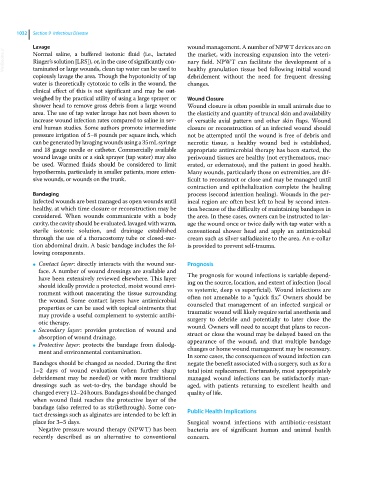Page 1094 - Clinical Small Animal Internal Medicine
P. 1094
1032 Section 9 Infectious Disease
Lavage wound management. A number of NPWT devices are on
VetBooks.ir Ringer’s solution [LRS]), or, in the case of significantly con- the market, with increasing expansion into the veteri-
Normal saline, a buffered isotonic fluid (i.e., lactated
nary field. NPWT can facilitate the development of a
taminated or large wounds, clean tap water can be used to
debridement without the need for frequent dressing
copiously lavage the area. Though the hypotonicity of tap healthy granulation tissue bed following initial wound
water is theoretically cytotoxic to cells in the wound, the changes.
clinical effect of this is not significant and may be out-
weighed by the practical utility of using a large sprayer or Wound Closure
shower head to remove gross debris from a large wound Wound closure is often possible in small animals due to
area. The use of tap water lavage has not been shown to the elasticity and quantity of truncal skin and availability
increase wound infection rates compared to saline in sev- of versatile axial pattern and other skin flaps. Wound
eral human studies. Some authors promote intermediate closure or reconstruction of an infected wound should
pressure irrigation of 5–8 pounds per square inch, which not be attempted until the wound is free of debris and
can be generated by lavaging wounds using a 35 mL syringe necrotic tissue, a healthy wound bed is established,
and 18 gauge needle or catheter. Commercially available appropriate antimicrobial therapy has been started, the
wound lavage units or a sink sprayer (tap water) may also periwound tissues are healthy (not erythematous, mac-
be used. Warmed fluids should be considered to limit erated, or edematous), and the patient in good health.
hypothermia, particularly in smaller patients, more exten- Many wounds, particularly those on extremities, are dif-
sive wounds, or wounds on the trunk. ficult to reconstruct or close and may be managed until
contraction and epithelialization complete the healing
Bandaging process (second intention healing). Wounds in the per-
Infected wounds are best managed as open wounds until ineal region are often best left to heal by second inten-
healthy, at which time closure or reconstruction may be tion because of the difficulty of maintaining bandages in
considered. When wounds communicate with a body the area. In these cases, owners can be instructed to lav-
cavity, the cavity should be evaluated, lavaged with warm, age the wound once or twice daily with tap water with a
sterile isotonic solution, and drainage established conventional shower head and apply an antimicrobial
through the use of a thoracostomy tube or closed‐suc- cream such as silver sulfadiazine to the area. An e‐collar
tion abdominal drain. A basic bandage includes the fol- is provided to prevent self‐trauma.
lowing components.
Contact layer: directly interacts with the wound sur- Prognosis
●
face. A number of wound dressings are available and
have been extensively reviewed elsewhere. This layer The prognosis for wound infections is variable depend-
should ideally provide a protected, moist wound envi- ing on the source, location, and extent of infection (local
ronment without macerating the tissue surrounding vs systemic, deep vs superficial). Wound infections are
the wound. Some contact layers have antimicrobial often not amenable to a “quick fix.” Owners should be
properties or can be used with topical ointments that counseled that management of an infected surgical or
may provide a useful complement to systemic antibi- traumatic wound will likely require serial anesthesia and
otic therapy. surgery to debride and potentially to later close the
Secondary layer: provides protection of wound and wound. Owners will need to accept that plans to recon-
● struct or close the wound may be delayed based on the
absorption of wound drainage.
Protective layer: protects the bandage from dislodg- appearance of the wound, and that multiple bandage
● changes or home wound management may be necessary.
ment and environmental contamination.
In some cases, the consequences of wound infection can
Bandages should be changed as needed. During the first negate the benefit associated with a surgery, such as for a
1–2 days of wound evaluation (when further sharp total joint replacement. Fortunately, most appropriately
debridement may be needed) or with more traditional managed wound infections can be satisfactorily man-
dressings such as wet‐to‐dry, the bandage should be aged, with patients returning to excellent health and
changed every 12–24 hours. Bandages should be changed quality of life.
when wound fluid reaches the protective layer of the
bandage (also referred to as strikethrough). Some con-
tact dressings such as alginates are intended to be left in Public Health Implications
place for 3–5 days. Surgical wound infections with antibiotic‐resistant
Negative pressure wound therapy (NPWT) has been bacteria are of significant human and animal health
recently described as an alternative to conventional concern.

